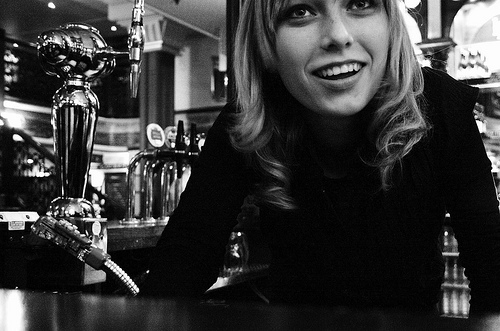Photo:flickr/Petras Gagilas
We’ve all been there: waiting at the bar, dying for a drink, but unable to catch the bartender’s attention. It’s easy to assume that we are being served (or rather, ignored) by a crappy bartender. But maybe it’s us. Maybe we’re the ones not giving the right signals that say “Beer me! Now!”. This is actually the best-case scenario, because it’s fixable, and these German scientists are here to help (and, eventually, to build a bartending robot). To determine the best way to signal to a bartender that you want a drink, they recorded real customer-bartender interactions and determined which signals caused patrons to be served: “The results revealed that bar staff responded to a set of two non-verbal signals: first, customers position themselves directly at the bar counter and, secondly, they look at a member of staff. Both signals were necessary and, when occurring together, sufficient.” And there you have it, folks. In terms of proving cause and effect, it doesn’t get better than “necessary and sufficient”. So, the next time you fail to get served at a bar, remember that it might not be the bartender–it might be you.
Automatic detection of service initiation signals used in bars.
“Recognizing the intention of others is important in all social interactions, especially in the service domain. Enabling a bartending robot to serve customers is particularly challenging as the system has to recognize the social signals produced by customers and respond appropriately. Detecting whether a customer would like to order is essential for the service encounter to succeed. This detection is particularly challenging in a noisy environment with multiple customers. Thus, a bartending robot has to be able to distinguish between customers intending to order, chatting with friends or just passing by. In order to study which signals customers use to initiate a service interaction in a bar, we recorded real-life customer-staff interactions in several German bars. These recordings were used to generate initial hypotheses about the signals customers produce when bidding for the attention of bar staff. Two experiments using snapshots and short video sequences then tested the validity of these hypothesized candidate signals. The results revealed that bar staff responded to a set of two non-verbal signals: first, customers position themselves directly at the bar counter and, secondly, they look at a member of staff. Both signals were necessary and, when occurring together, sufficient. The participants also showed a strong agreement about when these cues occurred in the videos. Finally, a signal detection analysis revealed that ignoring a potential order is deemed worse than erroneously inviting customers to order. We conclude that (a) these two easily recognizable actions are sufficient for recognizing the intention of customers to initiate a service interaction, but other actions such as gestures and speech were not necessary, and (b) the use of reaction time experiments using natural materials is feasible and provides ecologically valid results.”
The full text of the research article can be found here.
Related content:
NCBI ROFL: Naturalistic observations of beer drinking among college students.
NCBI ROFL: If you want to sell more alcohol, touch your customers.
NCBI ROFL: Oktoberfest week: The top 11 ways to appear drunk.
